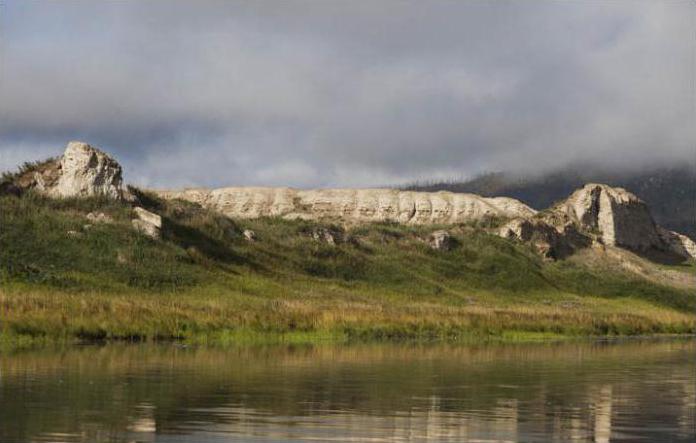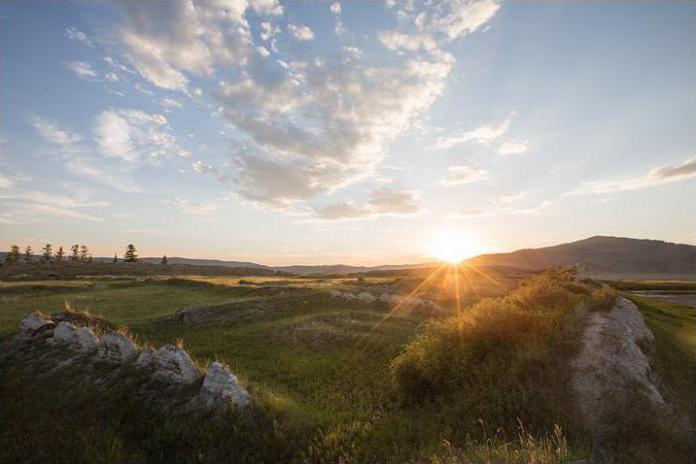The history of the discovery of this unique lake is associated with numerous local legends.
At high altitude is one of the most mysterious and beautiful places on the planet. This is the Tere-Khol lake, shrouded in unsolved mysteries until now.
Location
Tere-Khol - Lake Tyva, located in the southeastern territory of the okrug, almost on the border with the Republic of Mongolia. This is one of the most beautiful places in Siberia.
Six kilometers from it, in the west, is the village of Kungurtug, which is the center of the Tere-Kholsky district.
In geological terms, the reservoir is located in a basin of tectonic origin. On the lake itself there is a historically amazing island with the remains of the Uyghur fortress built on it in the 8th century AD. It is called Por-Bazhyn.
It should be noted that part of the lake is located in Mongolia.
Description of Tere Khol Lake
A fairly large structurally freshwater, but relatively shallow in depth lake has a dozen islands. It stretched from south to north for tens of kilometers, it is difficult to get to it, since it is quite high (1300 m above sea level). The depth of the greater part of the reservoir is about 7 meters, length - 16 km, width - 4 kilometers. The surroundings are mostly deserted, only occasionally shrubs can be found. The lake is part of the Ubsunur Basin Reserve.
The Saldam River flows from it, which is the right tributary of the Balyktig-Khem, which, in turn, flows into the Small Yenisei on the right (Kaa-Khem in the local one). Small rivers flow into the lake itself: from the south-west - Kyzyltykty, from the south - Bazhyrganak, from the south-east - Kungurtug. One curious fact should be noted: in August 2007, a pedestrian bridge was seen in a satellite image, which was drawn from the southeastern shore of the lake to the Por-Bazhyn fortress.
The mysterious lake of Siberia Tere-Khol is a repository of many puzzles that scientists are still struggling with. The water in it seems light green from the algae growing in it. And on the smooth surface of one tone, almost from edge to edge, a dark strip can be traced, the origin of which is one of the mysteries of the reservoir.
From past
The history of Lake Tere Khol is amazing. An employee of the Minusinsk Museum of Local Lore and ethnographer D. Klements in 1891 got into exile in the Siberian territories for his popular work. On the spot, he organized a scientific expedition, the purpose of which was to study the Uryankhai Territory and Northern Mongolia. Researchers in May of that year ended up in the village of Kungurtug. In it they found a local resident guide. Dmitry Klements intended to head west with the group, but the conductor began to dissuade him from such an undertaking, explaining this by the fact that at 3 hours from them there was a lake guarded by formidable spirits. This information was even more interesting for the scientist, and the next day the travelers went in that direction, but without a frightened guide.

According to the researcher, the problems started a couple of kilometers from the final destination. There was a feeling that some invisible force did not want to let them in to the treasured lake. Either the horse broke his leg, or the friend of the researcher I. Shaidurov received numerous bruises, having fallen into a hole well disguised as a bush. And at the very Tere-Khol lake, the loaded horses suddenly stopped, not wanting to move on.
Researchers had to approach an unattractive reservoir without draft power. The daredevils opened a muddy mirror of a large reservoir, in the middle of which was an island with the ruins of an unusual structure.
In addition to the expedition of D. Klements, there were two more groups of researchers who visited this mysterious place, which all the time presented new puzzles to which there are still no answers.
Legends
The mystery of the ancient lake Tere-Khol (Tuva) and the fortress Por-Bazhyn located on it gave rise to many legends. One of them says that here on a flat field there was a large palace in which one khan lived. Once his servant saw a fish in a well and told the Khan about it. He replied that these were worms, and that he would no longer drink water from this well. And the water got angry at such a stupid statement and began to pour out of the well. Then the khan had to run away, but, looking back, he exclaimed: “Tere-Nur!” And this is translated from Mongolian means "This is a lake!". The whole field was flooded, forming a lake. That palace remained on the island.
Traveler F. Ossendovsky also somehow heard from one aborigine the legend that until the 17th century a dry valley with a Chinese fortress in its very center stretched on the site of the lake. The commandant once insulted the local llama, and, offended, he cursed all the inhabitants of the military fortification. In the valley immediately appeared underground keys, instantly flooding it with water, destroying many soldiers of the emperor of the Middle Kingdom. In the twentieth century (in the 80s), this legend was confirmed in one of the scientific hypotheses of researchers of the USSR. They suggested that the Siberian Lake Tere-Khol happened artificially about a thousand years ago. Its creators (Uighurs) decided to flood the valley for the safety of their fortress.
The legend of shamans
Shamans living in the village of Kungurtug and considered the guardians of the lake pass one amazing legend from generation to generation. This is an ancient legend about an old man who lived at least 500 years in a "fiery yurt" on Mount Kezhege. Elder Bachi had to protect the entrance to the underworld, located at the bottom of the lake, by the will of the spirits. He possessed amazing meditative abilities: he could walk barefoot on the surface of the Tere-Khol, could turn into a lynx, a wolf, and a fish (sturgeon). Once, a mediator on the shore of Lake Bachi was attacked by representatives of the Echik tribe, among whom one of the soldiers waved a blade at the old man, after which the lama extended his arms to the sky. Then there was a roar of thunder, and after that the soldiers turned into blocks of stones that immediately began to hide in the waters of the lake. Afflicted by such behavior of people, Bachi himself went into the dungeon.

As if to confirm this legend, the results of scanning the bottom of the lake and coastal areas with an echo sounder echo. Work carried out in the 1980s confirmed the presence of a coastal stone ridge and a mysterious hole located 3 kilometers from Por-Bazhyn. But the divers who examined the bottom of the lake did not find it.
About the fortress
The ruins of the fortress on Lake Tere-Khol, made of clay and located on about. Por-Bazhyn, for hundreds of years aroused the curiosity and interest of not only scientists.
The rectangular-shaped fortress with an intricate arrangement of buildings resembles a Buddhist mandala (a schematic design or image used in Hindu and Buddhist religious practices).
As a result of research by archaeologists and historians, it was revealed that the fortress was built in the VIII century by the Uyghurs, who at that time annexed the territory of the Sayano-Altai and the south of Tyva to their khanate. But further such a conclusion, the matter did not move. The purpose of these architectural structures is still the subject of controversy. These buildings can be ranked both in the temple complex and in the palace.
In the 1950s, archaeologists on the island discovered fragments of a water supply system, which is one of the oldest on the planet.
Underground caches
It is with the Por-Bazhyn fortress on Lake Tere-Khol that the population of these places has a legend about tunnels underground with the countless treasures of the former rulers - the founders of the Uigur Khaganate. Also, according to legend, it was believed that along these underground passages you can go around the whole Earth. And in fact, archaeologists often came across the dilapidated and littered entrances to the dungeons, which no one had yet managed to get into.
Scientists believe that the fortress was destroyed in the middle of the XVIII century as a result of an enemy raid, and the inhabitants of the citadel managed to hide their wealth in the dungeon caches until their death.
Ancient Observatory Hypothesis
On the walls of the fortifications there were intricate signs similar to symbols that have important esoteric meaning. They are similar to drawings found in the cities of the ancient Mayan civilization.
At the beginning of the 21st century, Irkutsk researcher I.V. Berdnikov suggested that the buildings of the complex located on Lake Tere-Khol represent a reproduction of a map of the starry sky that accurately imitates the outlines of the zodiac constellations. This prompted Berdnikov to the idea that an ancient observatory could be located on the island.
Gateway to Shambhala
For centuries, the elders of the tribes of the environs of Lake Tere-Khol believed that there are northern gates to Shambhala on the island. Legends and legends abound with information about mysterious strangers in sparkling clothes that appear from the side of the island. They predict the fate of people and warn them against risky and ill-conceived actions.
Ancient legends say that until the middle of the 10th century, shamans, who sensed the approach of death, performed one rite - sitting in the boat, they sailed away to the island forever. So they went "into the shining world."
On the lake in the 70-80s of the XX century there was a fishing artel. Its employees have repeatedly witnessed mysterious phenomena. For example, in the summer of 1981, on completely calm, clear weather, a boat with a fisherman, Donzum, was suddenly caught in an unexpected whirlpool. Fisherman brought to the shore of the island and cast into a dark grotto with the ship. In a grotto filled with water and going deep into the island, far inside, a white light appeared, which gradually grew. Against this background, silhouettes began to appear, as if soaring in the air, and an unknown force began to draw the fisherman into the depths of the grotto. The fisherman came to his senses and began to feverishly row the oars and was able to swim to the surface of the lake.
Holidays on Lake Tere-Khol (Tuva)
Recreation facilities are located on the shores of the reservoir. There are campsites, cottages where tourists can stay for a certain period of time for relaxation. For lovers of romance and exoticism there are yurts made of felt.
It offers guests a small restaurant and a Russian bath. There are playgrounds for playing volleyball and football, a small water park, tennis tables and billiards, a dance floor.
Every year, hundreds of tourists come to the wonderful Lake Tere-Khol to relax surrounded by the amazingly beautiful nature of the reserve, to personally touch an interesting history, to feel the original traditions and customs of the peoples of Central Asia. It is very interesting to listen to the legends about the lake, which gives rise to the great Russian river Yenisei.